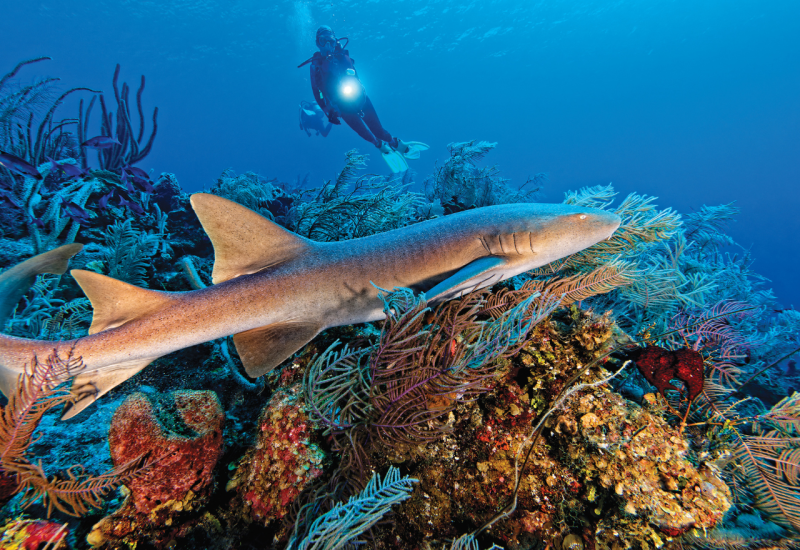Florida Goliath Grouper Spawning: An Underwater Orgy
Some photography courtesy of National Geographic, from its July 2014 issue. Click here to see the full photo gallery.
The Adventure Begins
From the outset, the plan seems more batter than baked. As I load my gear onto M/V Explorer at the dock in Boynton Beach, Florida, I look around and sense that the four divers assembled by Kevin Metz know it.
Through our exchanged emails days earlier, the dreadlocked captain couldn’t hide his excitement.
He works for the dive operation Underwater Explorers, which means he has the keys — and the freedom to burn gas — to chase a phenomenon that most boat operators won’t. The charter on this September evening is invite-only.
A few months back, I’d been introduced to Metz via Brian Dombrowski, a technical diver who tracks underwater happenings. When the time came for goliath grouper aggregations, Dombrowski reached out to Metz, someone with a taste for exploration dives.
Epinephelus itajara, which can grow to nearly 10 feet and around 800 pounds, has been off-limits to fishermen since 1990. A year later, it was nearly declared endangered.
Now the population has rebounded, and the Florida reef residents gather by the hundreds in various offshore points to spawn, mostly in August and September. For divers, there’s no luck required to swim with dozens at this time, when they brazenly disregard people — they’re too busy seeking mates.
What hooked Dombrowski, Metz and me was the possibility of witnessing hundreds of grouper in the actual moment of release, as plumes of eggs and milt — fish sperm — swirl into the water column.
Unlike the coral spawns on Caribbean islands like Grand Cayman and Curaçao, the timing of this nighttime sex party was still one big TBD. As of that night, nobody had seen it.
“So where do we start looking?” I ask while schlepping tanks.
“That’s the easy part,” Metz says. For the past two months, the grouper have been aggregating at the M/V Castor, an artificial reef in 110 feet of water. In Jupiter, a coastal city 30 miles north, they meet up at the M-111.
What these two locations have in common are deep, warm water and a surging current — all turn-ons for this barrel-chested swimmer.
Through the dive reports of National Oceanic and Atmospheric Association scientists, fishermen, divers and even National Geographic photographer David Doubilet, Metz knew that the release of milky clouds coincides with the new moon.
Doubilet had been out on Explorer several times in the past week, enticed by the prospect of being the first to capture the spawn on film. He told Metz that he figured the best time is as close to dusk as possible. Whether this was advice for lighting a shot, locating the mass orgy with the naked eye or actual scientific intel, Metz wasn’t sure.
But when David Doubilet gives you a tip, you heed it.
I also learn that when the fish pair off, they ditch the wreck and swim out over the sand. Then, in the actual moment of fry-making, the fish change course, darting vertically in the water column — which, from a diver’s perspective, means that it will be nearly impossible to find them: a free-swimming needle in the Atlantic haystack.
I’m starting to feel like Tom Cruise in a fishy version of Eyes Wide Shut. The party is out there, and it’s going to take a hell of a lot of work to find it. But I’m not led by libido. I’ve got a loaded boat, flat seas, and three Diet Cokes coursing through my veins. Something has to happen.
Then I spy a toy in the stern. This is my first spawn-chasing rodeo, but it’s not for my fellow divers. Their batteries are charged.
In Search of the Spawning
"Are you comfortable grabbing my ankles?”
That’s how I meet divemaster Alex Borsutzky, owner of one diver propulsion vehicle. As Explorer motors out of the harbor, he tells me his plan to buzz ever-wider circles around the wreck to find the action. Apparently, he’s generous enough to sacrifice speed to show me around. It’s 30 minutes to the wreck; when we arrive, we find we’re not the only ones knocking at the party-house door.
Only, the folks aboard the other boat don’t seem to be sure if they’re coming or going. They fly no dive flag. No fishing lines run below the surface. It’s unclear what they’re doing out here. Only after we’re in the water, hovering over the bow of the Castor at 95 feet do we connect the dots. Ten feet of yellow polypropylene line dangles from the mouth of one grouper. Someone had been illegally attempting to haul in this fish, which explains why minutes before we dropped anchor, a scuba-suited guy thumped back aboard the mystery boat — and why the passengers barely responded to Metz’s yelled offers to help them with their stuck anchor, the only logical explanation for why they were lingering. Turns out that despite the goliath’s protected status, some yahoos can’t ignore 700 pounds of temptation.
There’s nothing we can do about that right now, with bottom time dwindling and the last crumbs of daylight disappearing. Borsutzky buzzes up to me, palms upturned: a question.
I return the gesture and shake my head, answering no, I haven’t seen the grouper in numbers. And no sign of mating behavior: the rubbing of pectoral fins against bodies, the throaty thump of their aggressive cries. In the past week, during day trips with Jupiter Dive Center a few miles up the coast, I’d seen grouper by the dozens. I’d sheltered behind a piling as I watched one slide belly-up below me, eyeing my movements. Like middle-schoolers at a dance, they formed little pods, nestling near one another but not making big moves. So far, on this night, I had laid eyes on two, maybe three at a time, but they were clearly on the move, not as leisurely as they’d been in daylight.
Borsutzky signals that he’s going to make another sweep. He disappears. Suddenly, I realize how thickly dark it is. Foolishly, I failed to dive this wreck in the daylight. I don’t know where I am going.
Rising through the ranks of the dive world is a funny thing: The more experience you gain, the more other divers will grant you more leeway, a sign of respect. The leash gets ever looser, until you find yourself practicing the “buddies in the same ocean” style of diving.
Realizing I’m quickly becoming separated from our loosely knit group, I make my way toward the only lights I can see. They belong to a customer who didn’t offer to be my guide. He has a camera, so I pass the rest of the dive staying a few yards behind him as he photographs the giants crowding inside the superstructure. I spin my light into the black wilderness around me, wondering about the odds that I will stumble upon magic.
I’m the first back on the boat. Heat lightning cracks white above the cityscape and open ocean.
When Metz asks, I say I heard a couple of thundering grunts. I also tell him that the current seems fairly strong, but when my makeshift buddy climbs back aboard, he reports the opposite, explaining that the flow of water over the ship creates a sweeping force — this is what I felt. Otherwise, he deems this a calm night in terms of current. Borsutzky starts cleaning his scooter.
He swears he’s not using it again. “I need a helmet! I can’t see the wreck until I’ve almost hit it.” The fourth diver in our party, Rick Scott, starts asking how the grouper responded to our lights. He’s vexed, working out aloud how to rig his gear. He needs his dive lights to see but thinks his camera strobes scared the subjects.
Borsutzky laughs. “Don’t they know it’s more fun with the lights on?”
With an hour to kill on the surface, we tweak our plan. While we were in the water, Metz had been eyeing the fish finder. “Were you seeing them around the superstructure? They should be stacking up in about 40 to 60 feet.”
We jump in again, armed with suggestions from Metz. The group stays more or less together this dive, and I watch Scott’s strobes. Like a photo booth, every few moments, the bulbs fire. Grouper with tails thrashing against one another. Grouper spinning upward in the water column. Grouper dive-bombing toward the sand.
It’s funny — I had mostly figured that none of us would hit the jackpot and see that eggy cloud. But there’s an electricity in hoping, in knowing that we’re yards, maybe even feet, from something no human has seen, or at least captured on film. In a way, these behaviors are among the last frontiers in the world — a few undiscovered moments. By the time I assent to my computer’s suggestion to call the dive, my body is shaking from cold.
In a fog of wonder, I drive the three hours home in silence. I can’t stop thinking about what to do differently should I again get the chance to search for this mating moment.
I’m deep into my second cup of coffee the next morning when I see an email from Scott. He apologizes that the shot isn’t in better focus. Yet, amid the nine grouper captured in the frame is the most wondrous thing. It’s like an enormous dust storm kicked up by a motorcycle in the desert. Scale is hard to judge, but this cloud of beginnings stretches maybe 20 feet tall. It’s like a speckled cosmos at the tail, and thick cotton candy in the center. I’m mesmerized. It’s a good five minutes before I see that Scott also wrote a few lines explaining how he managed this single frame. Frustrated that his dive lights were scaring away the very thing he came to see, he resolved to stay still in the blackness, watching. When the shadows edged in near enough, he squeezed the shutter. Beyond that, Scott says he was simply shooting in the dark.
In a way, we all were, hoping against lightning-like odds that magic would simply fall in our laps and that — like the grouper — we’d get lucky too.
Plan Your Trip
When To Go
The goliath grouper spawning off the southeast Florida coast coincides with the new moons of August, September and sometimes October. For the best chances of seeing, drop in as close to dusk as possible.
Dive Conditions
August water temps are about 86 degrees F; seas are generally calm. September is a transitional month, so conditions vary. However, water temps are consistently in the high 70s.
Operators
Underwater Explorers, based in Boynton Beach is already planning its fall night-diving schedule; call or email the dive shop for details. Jupiter Dive Center also offers night dives upon request for groups of four or more. To make this night dive, you must be advanced open water and nitrox certified.
PRICE TAG Underwater Explorers charges $65 for a two-dive day charter and $70 for two dips at night. Jupiter Dive Center asks $70 for a daytime two-tank trip, and $80 for its two-dive nighttime excursions. Note that both operators charge extra for tanks and rental gear.
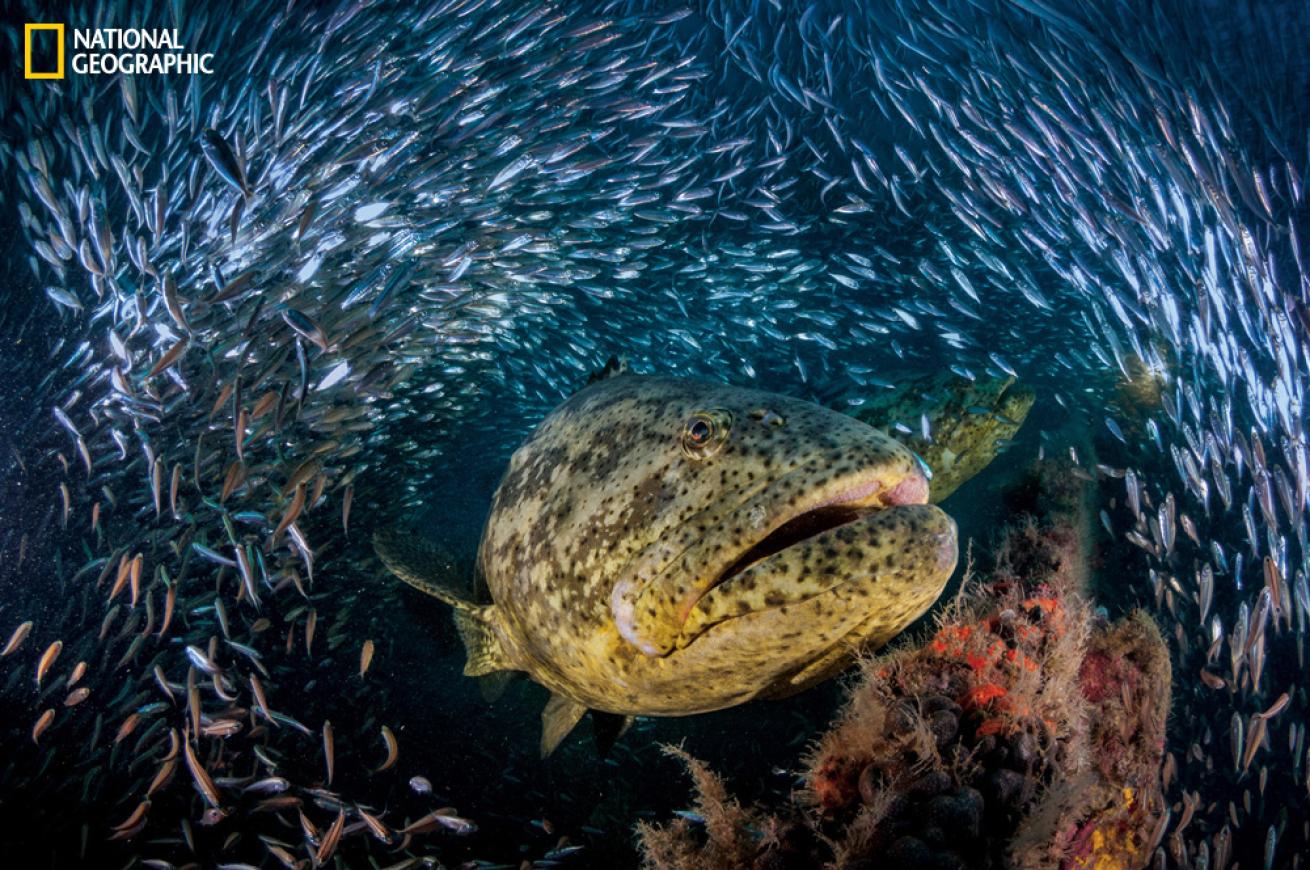
© David Doubilet and Jennifer Hayes/National Geographic
Goliath groupers emerge from a blizzard of baitfish on a WWII shipwreck off Florida.
Photo and caption courtesy of National Geographic
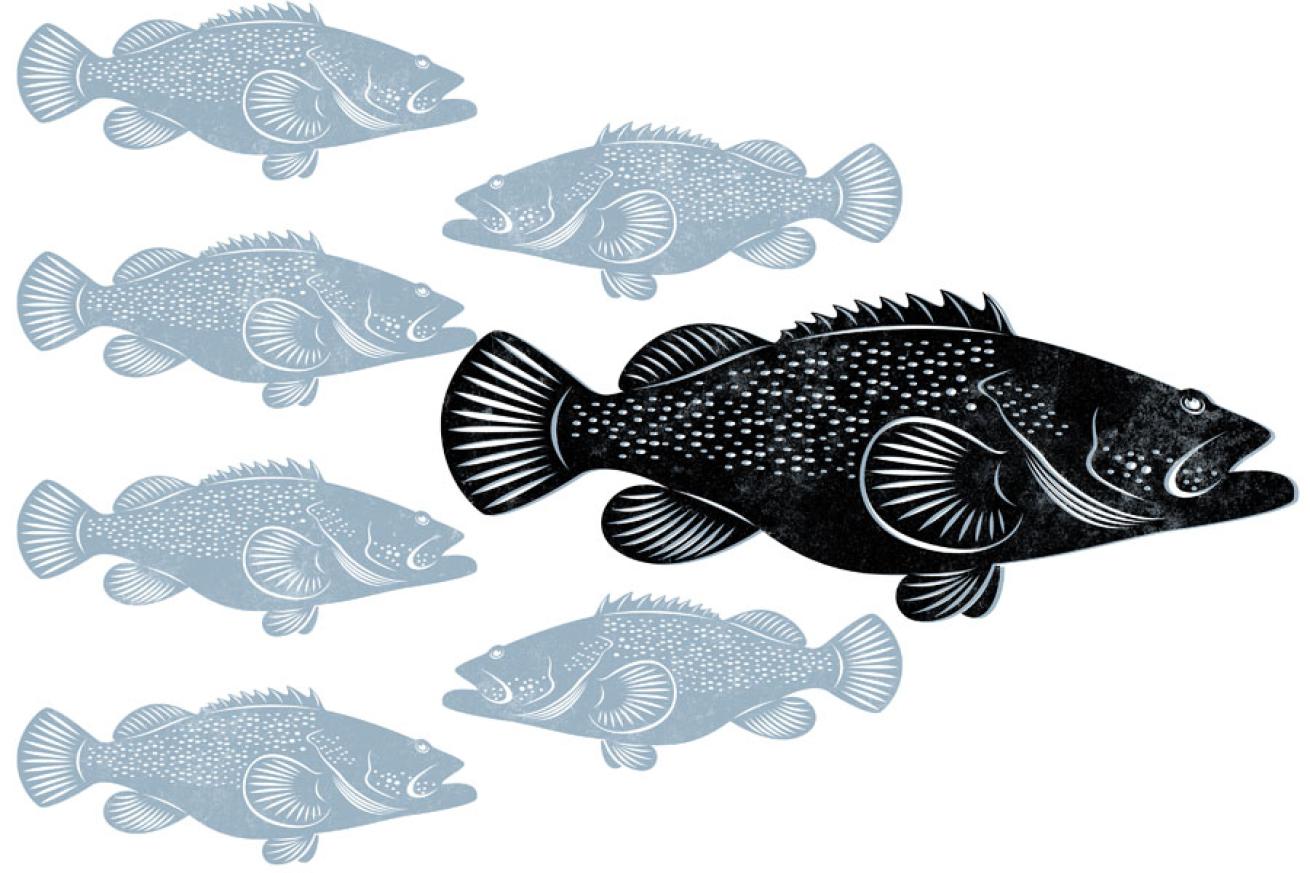
Istock
Witnessing a goliath grouper spawning almost never happens, but that makes divers only more eager to join the hunt.
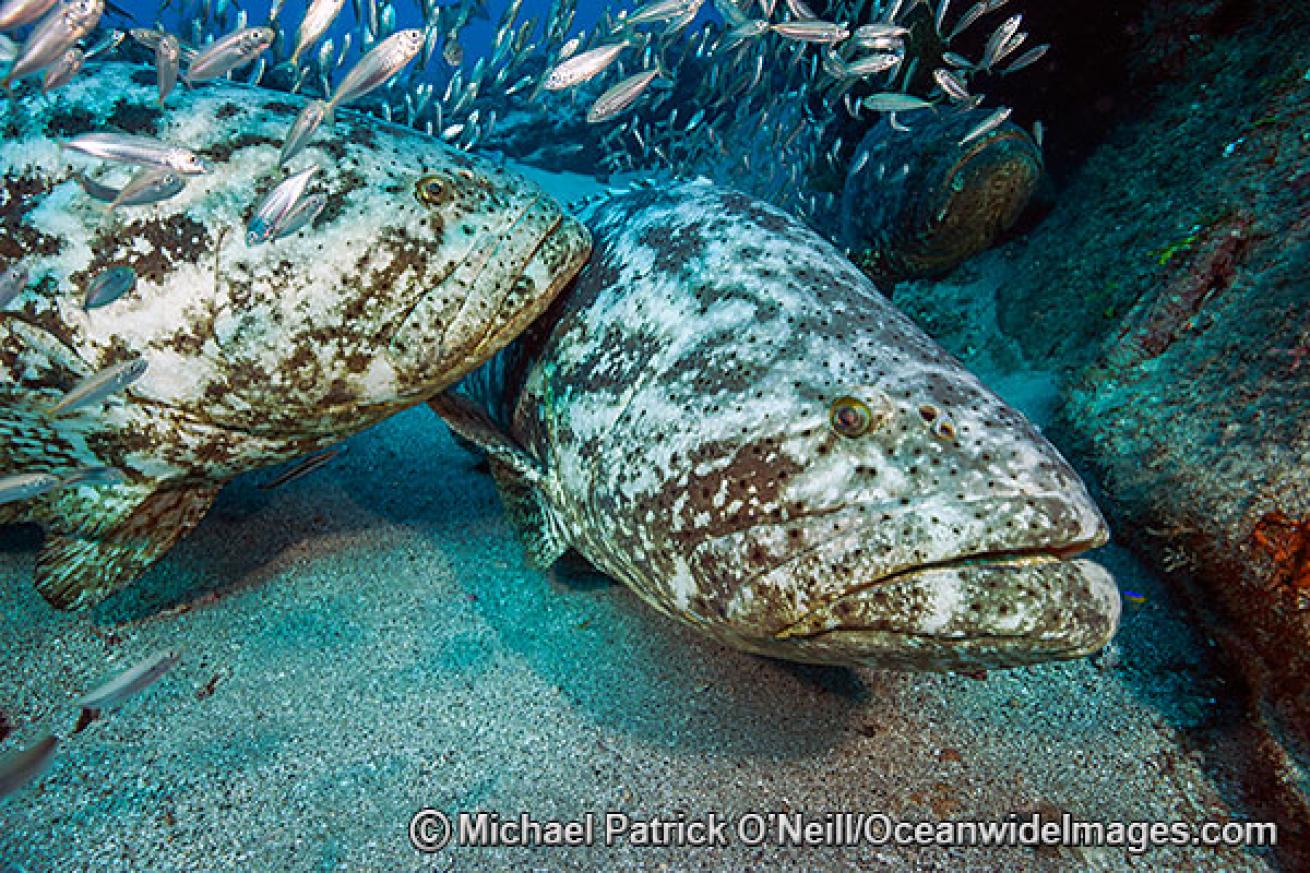
Michael Patrick O'Neill/Ocean Wide Images
The population of Florida's goliath grouper has rebounded since reaching near-endangered status in the ’90s.
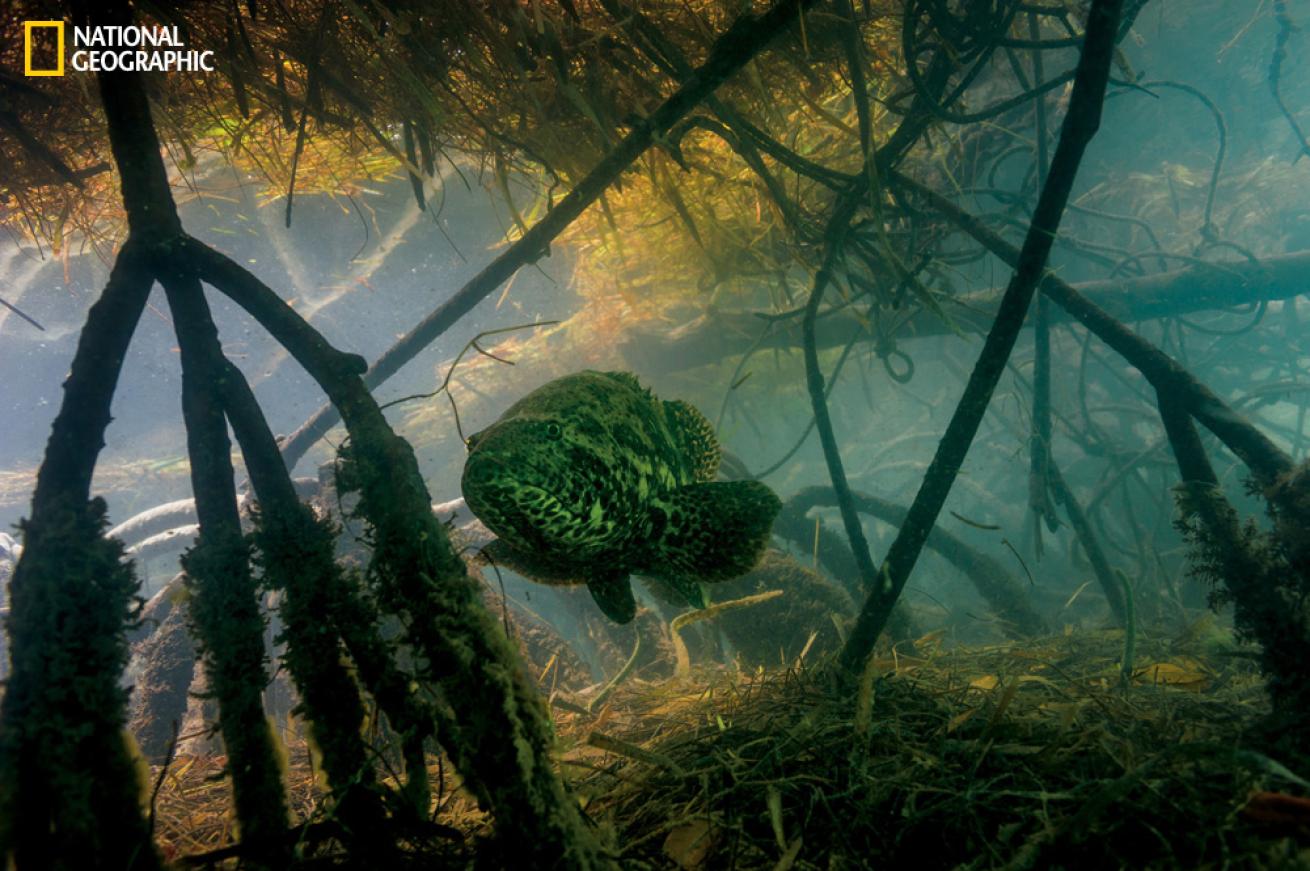
© David Doubilet and Jennifer Hayes/National Geographic
This 10-inch-long juvenile goliath in the Florida Keys may spend five years among mangroves, relatively safe from predators, before venturing out to the reefs. The species’ survival depends on mangrove forests, which are contending with coastal development.
_Photo and caption courtesy of __National Geographic_
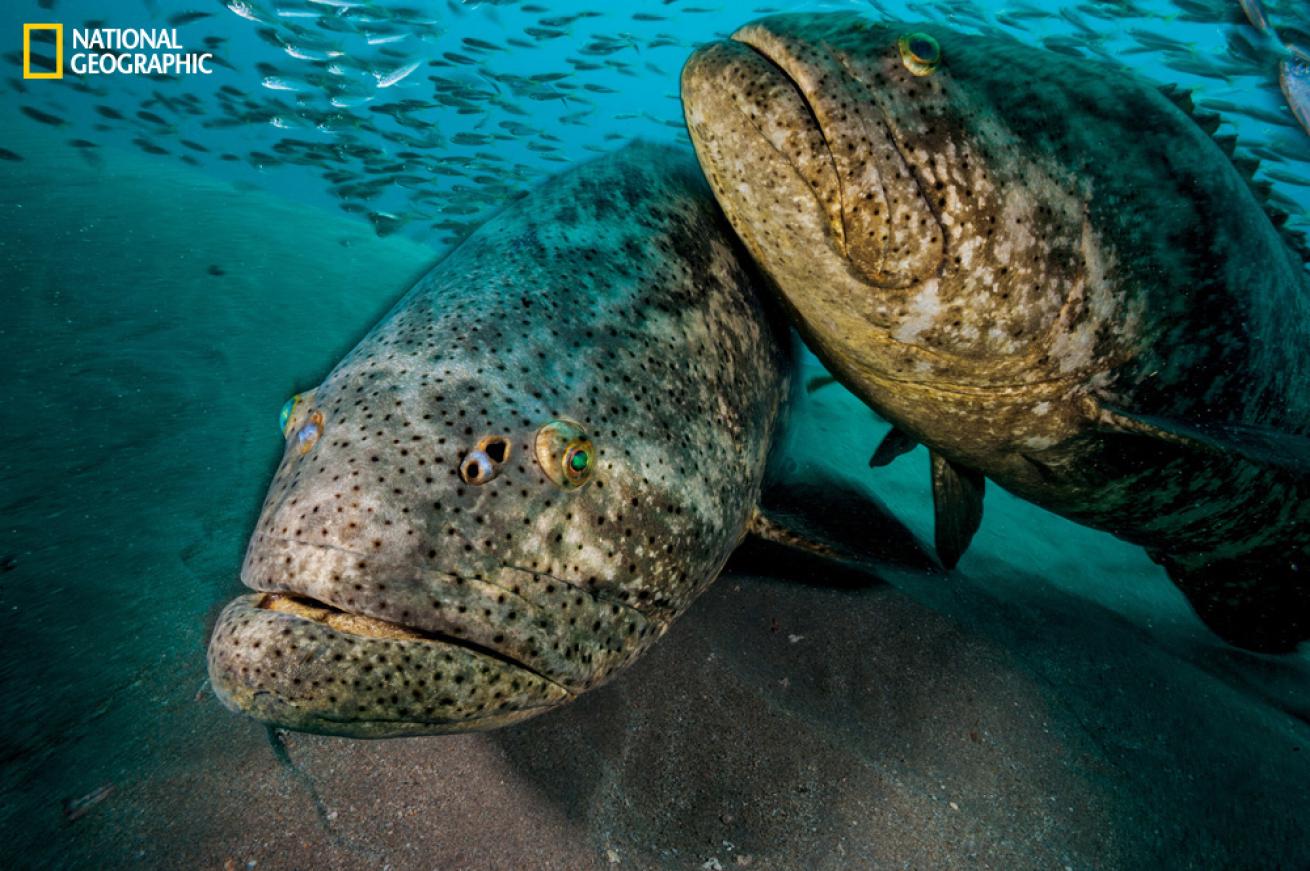
© David Doubilet and Jennifer Hayes/National Geographic
Gregarious and physical, goliaths are rarely seen solo and seem to socialize equally across the sexes. Recently scientists discovered that some are “protogynous hermaphrodites,” meaning they are born females but transform into males. It isn’t yet clear why they evolved this way.
_Photo and caption courtesy of __National Geographic_
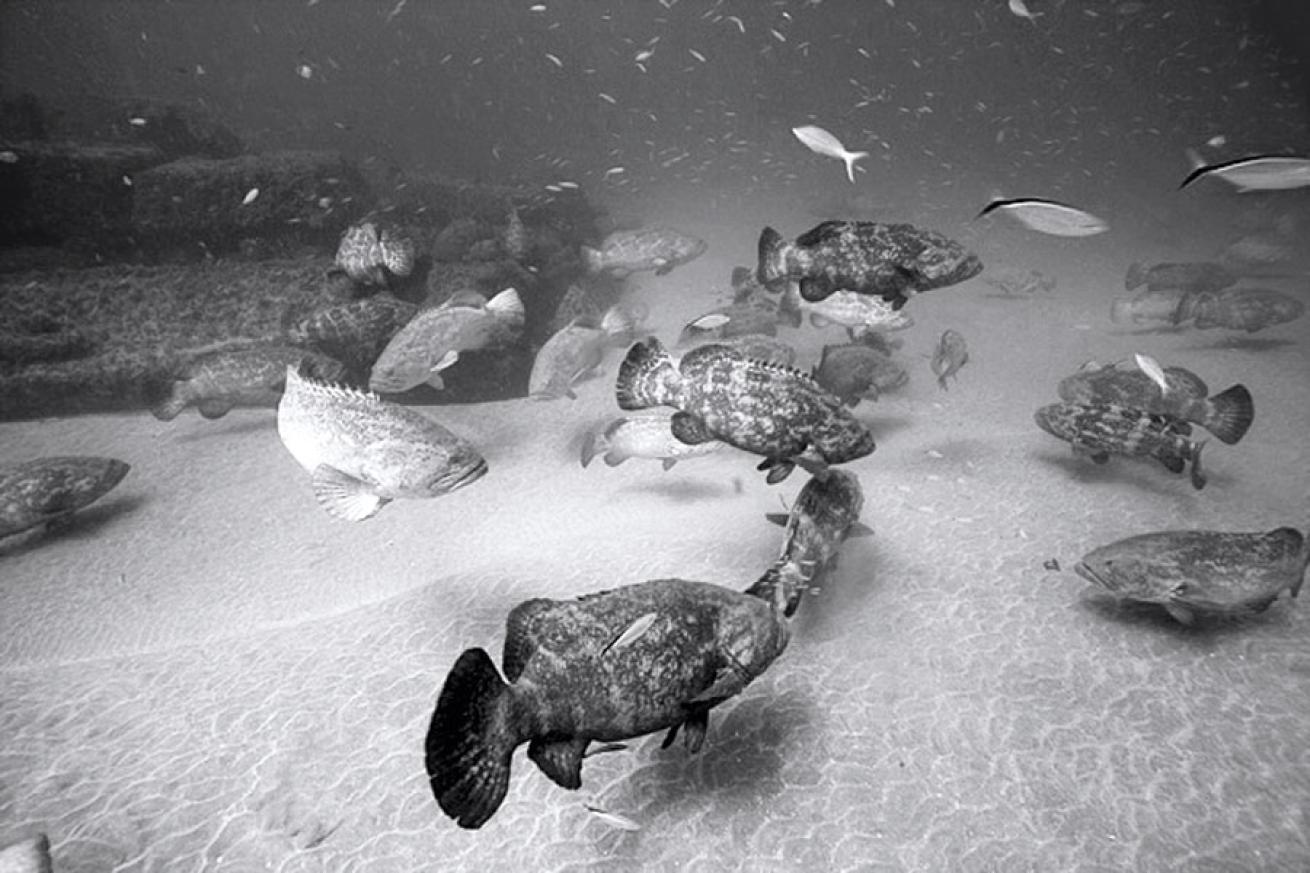
MCT Via Getty Images
Goliath grouper congregate off the coast of Florida to spawn in August and September.
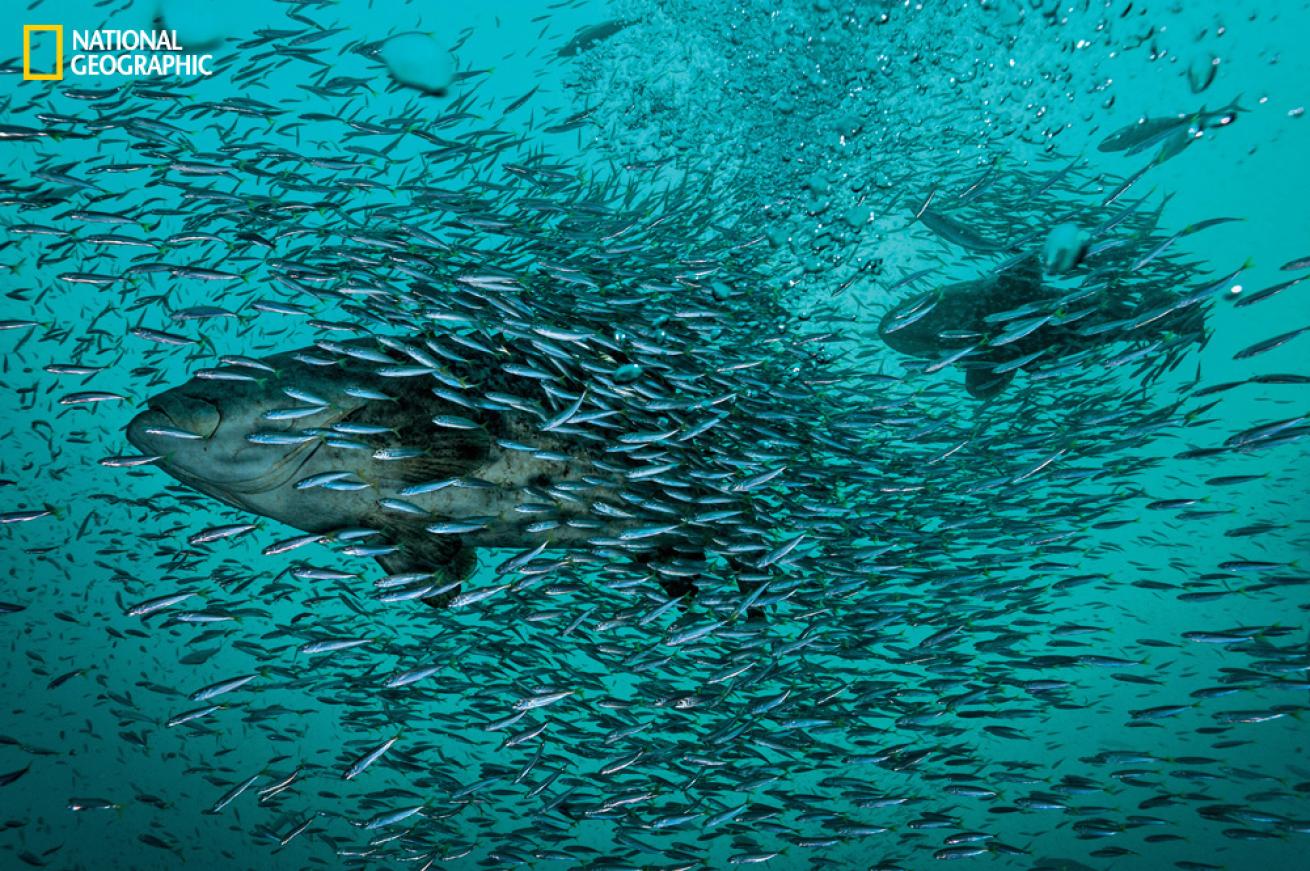
© David Doubilet and Jennifer Hayes/National Geographic
Baitfish cloak a female goliath as she prepares to spawn with a nearby male. When ready, she will release thousands of eggs near the surface; the male will follow with a cloud of sperm. And the baitfish will feast on as many eggs as they can before the current clears the scene.
_Photo and caption courtesy of __National Geographic_
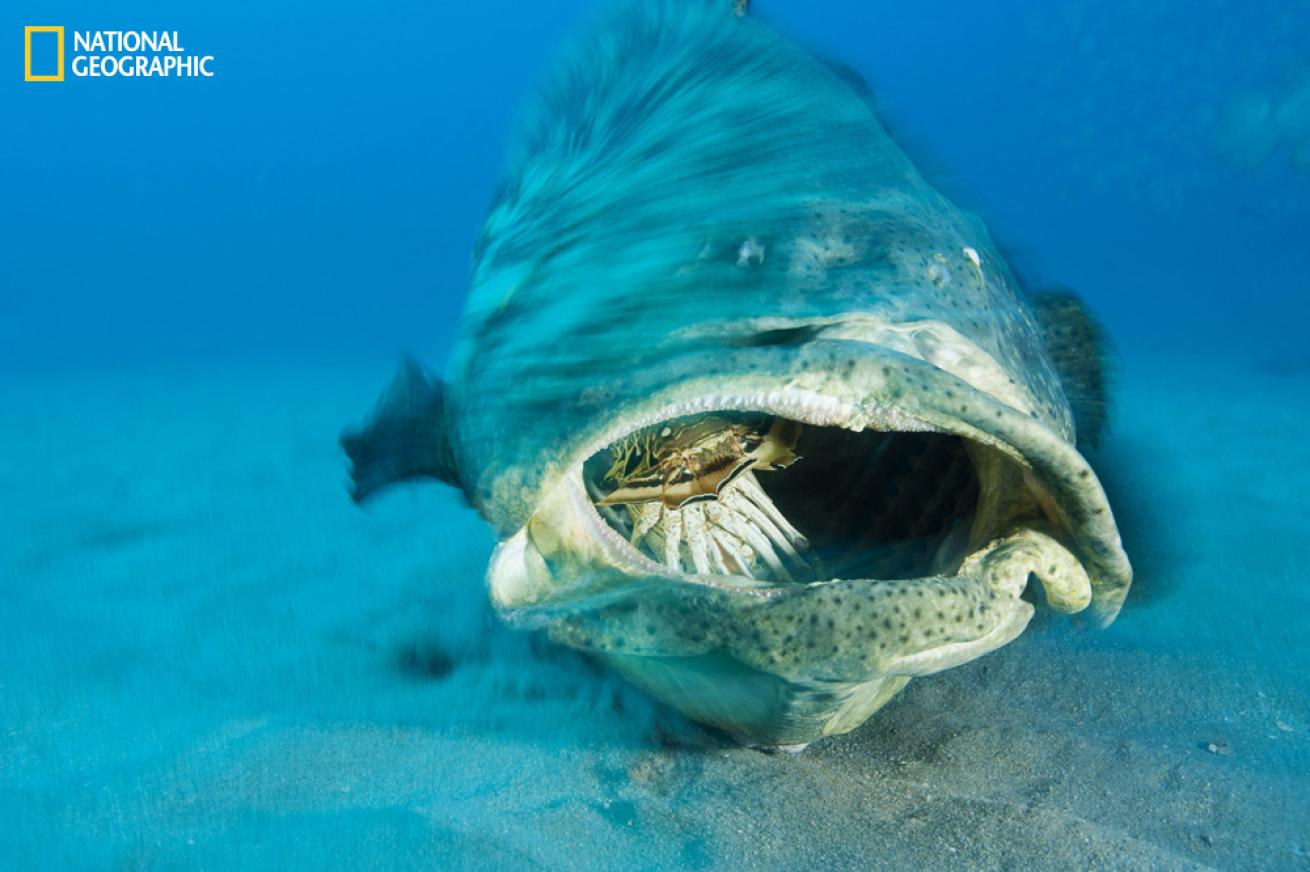
© David Doubilet and Jennifer Hayes/National Geographic
Goliaths do sometimes eat the big crustaceans, but they prefer to dine on sand-burrowing crabs.
_Photo and caption courtesy of __National Geographic_

© David Doubilet and Jennifer Hayes/National Geographic
Photography by David Doubilet and Jennifer Hayes courtesy of National Geographic magazine. To see the full photo gallery go to: http://ngm.nationalgeographic.com/2014/07/goliath-grouper/doubilet-hayes.
Some photography courtesy of National Geographic, from its July 2014 issue. Click here to see the full photo gallery.
The Adventure Begins
From the outset, the plan seems more batter than baked. As I load my gear onto M/V Explorer at the dock in Boynton Beach, Florida, I look around and sense that the four divers assembled by Kevin Metz know it.
Through our exchanged emails days earlier, the dreadlocked captain couldn’t hide his excitement.
He works for the dive operation Underwater Explorers, which means he has the keys — and the freedom to burn gas — to chase a phenomenon that most boat operators won’t. The charter on this September evening is invite-only.
A few months back, I’d been introduced to Metz via Brian Dombrowski, a technical diver who tracks underwater happenings. When the time came for goliath grouper aggregations, Dombrowski reached out to Metz, someone with a taste for exploration dives.
Epinephelus itajara, which can grow to nearly 10 feet and around 800 pounds, has been off-limits to fishermen since 1990. A year later, it was nearly declared endangered.
Now the population has rebounded, and the Florida reef residents gather by the hundreds in various offshore points to spawn, mostly in August and September. For divers, there’s no luck required to swim with dozens at this time, when they brazenly disregard people — they’re too busy seeking mates.
What hooked Dombrowski, Metz and me was the possibility of witnessing hundreds of grouper in the actual moment of release, as plumes of eggs and milt — fish sperm — swirl into the water column.
Unlike the coral spawns on Caribbean islands like Grand Cayman and Curaçao, the timing of this nighttime sex party was still one big TBD. As of that night, nobody had seen it.
“So where do we start looking?” I ask while schlepping tanks.
“That’s the easy part,” Metz says. For the past two months, the grouper have been aggregating at the M/V Castor, an artificial reef in 110 feet of water. In Jupiter, a coastal city 30 miles north, they meet up at the M-111.
What these two locations have in common are deep, warm water and a surging current — all turn-ons for this barrel-chested swimmer.
Through the dive reports of National Oceanic and Atmospheric Association scientists, fishermen, divers and even National Geographic photographer David Doubilet, Metz knew that the release of milky clouds coincides with the new moon.
Doubilet had been out on Explorer several times in the past week, enticed by the prospect of being the first to capture the spawn on film. He told Metz that he figured the best time is as close to dusk as possible. Whether this was advice for lighting a shot, locating the mass orgy with the naked eye or actual scientific intel, Metz wasn’t sure.
But when David Doubilet gives you a tip, you heed it.
I also learn that when the fish pair off, they ditch the wreck and swim out over the sand. Then, in the actual moment of fry-making, the fish change course, darting vertically in the water column — which, from a diver’s perspective, means that it will be nearly impossible to find them: a free-swimming needle in the Atlantic haystack.
I’m starting to feel like Tom Cruise in a fishy version of Eyes Wide Shut. The party is out there, and it’s going to take a hell of a lot of work to find it. But I’m not led by libido. I’ve got a loaded boat, flat seas, and three Diet Cokes coursing through my veins. Something has to happen.
Then I spy a toy in the stern. This is my first spawn-chasing rodeo, but it’s not for my fellow divers. Their batteries are charged.
In Search of the Spawning
"Are you comfortable grabbing my ankles?”
That’s how I meet divemaster Alex Borsutzky, owner of one diver propulsion vehicle. As Explorer motors out of the harbor, he tells me his plan to buzz ever-wider circles around the wreck to find the action. Apparently, he’s generous enough to sacrifice speed to show me around. It’s 30 minutes to the wreck; when we arrive, we find we’re not the only ones knocking at the party-house door.
Only, the folks aboard the other boat don’t seem to be sure if they’re coming or going. They fly no dive flag. No fishing lines run below the surface. It’s unclear what they’re doing out here. Only after we’re in the water, hovering over the bow of the Castor at 95 feet do we connect the dots. Ten feet of yellow polypropylene line dangles from the mouth of one grouper. Someone had been illegally attempting to haul in this fish, which explains why minutes before we dropped anchor, a scuba-suited guy thumped back aboard the mystery boat — and why the passengers barely responded to Metz’s yelled offers to help them with their stuck anchor, the only logical explanation for why they were lingering. Turns out that despite the goliath’s protected status, some yahoos can’t ignore 700 pounds of temptation.
There’s nothing we can do about that right now, with bottom time dwindling and the last crumbs of daylight disappearing. Borsutzky buzzes up to me, palms upturned: a question.
I return the gesture and shake my head, answering no, I haven’t seen the grouper in numbers. And no sign of mating behavior: the rubbing of pectoral fins against bodies, the throaty thump of their aggressive cries. In the past week, during day trips with Jupiter Dive Center a few miles up the coast, I’d seen grouper by the dozens. I’d sheltered behind a piling as I watched one slide belly-up below me, eyeing my movements. Like middle-schoolers at a dance, they formed little pods, nestling near one another but not making big moves. So far, on this night, I had laid eyes on two, maybe three at a time, but they were clearly on the move, not as leisurely as they’d been in daylight.
Borsutzky signals that he’s going to make another sweep. He disappears. Suddenly, I realize how thickly dark it is. Foolishly, I failed to dive this wreck in the daylight. I don’t know where I am going.
Rising through the ranks of the dive world is a funny thing: The more experience you gain, the more other divers will grant you more leeway, a sign of respect. The leash gets ever looser, until you find yourself practicing the “buddies in the same ocean” style of diving.
Realizing I’m quickly becoming separated from our loosely knit group, I make my way toward the only lights I can see. They belong to a customer who didn’t offer to be my guide. He has a camera, so I pass the rest of the dive staying a few yards behind him as he photographs the giants crowding inside the superstructure. I spin my light into the black wilderness around me, wondering about the odds that I will stumble upon magic.
I’m the first back on the boat. Heat lightning cracks white above the cityscape and open ocean.
When Metz asks, I say I heard a couple of thundering grunts. I also tell him that the current seems fairly strong, but when my makeshift buddy climbs back aboard, he reports the opposite, explaining that the flow of water over the ship creates a sweeping force — this is what I felt. Otherwise, he deems this a calm night in terms of current. Borsutzky starts cleaning his scooter.
He swears he’s not using it again. “I need a helmet! I can’t see the wreck until I’ve almost hit it.” The fourth diver in our party, Rick Scott, starts asking how the grouper responded to our lights. He’s vexed, working out aloud how to rig his gear. He needs his dive lights to see but thinks his camera strobes scared the subjects.
Borsutzky laughs. “Don’t they know it’s more fun with the lights on?”
With an hour to kill on the surface, we tweak our plan. While we were in the water, Metz had been eyeing the fish finder. “Were you seeing them around the superstructure? They should be stacking up in about 40 to 60 feet.”
We jump in again, armed with suggestions from Metz. The group stays more or less together this dive, and I watch Scott’s strobes. Like a photo booth, every few moments, the bulbs fire. Grouper with tails thrashing against one another. Grouper spinning upward in the water column. Grouper dive-bombing toward the sand.
It’s funny — I had mostly figured that none of us would hit the jackpot and see that eggy cloud. But there’s an electricity in hoping, in knowing that we’re yards, maybe even feet, from something no human has seen, or at least captured on film. In a way, these behaviors are among the last frontiers in the world — a few undiscovered moments. By the time I assent to my computer’s suggestion to call the dive, my body is shaking from cold.
In a fog of wonder, I drive the three hours home in silence. I can’t stop thinking about what to do differently should I again get the chance to search for this mating moment.
I’m deep into my second cup of coffee the next morning when I see an email from Scott. He apologizes that the shot isn’t in better focus. Yet, amid the nine grouper captured in the frame is the most wondrous thing. It’s like an enormous dust storm kicked up by a motorcycle in the desert. Scale is hard to judge, but this cloud of beginnings stretches maybe 20 feet tall. It’s like a speckled cosmos at the tail, and thick cotton candy in the center. I’m mesmerized. It’s a good five minutes before I see that Scott also wrote a few lines explaining how he managed this single frame. Frustrated that his dive lights were scaring away the very thing he came to see, he resolved to stay still in the blackness, watching. When the shadows edged in near enough, he squeezed the shutter. Beyond that, Scott says he was simply shooting in the dark.
In a way, we all were, hoping against lightning-like odds that magic would simply fall in our laps and that — like the grouper — we’d get lucky too.
Plan Your Trip
When To Go
The goliath grouper spawning off the southeast Florida coast coincides with the new moons of August, September and sometimes October. For the best chances of seeing, drop in as close to dusk as possible.
Dive Conditions
August water temps are about 86 degrees F; seas are generally calm. September is a transitional month, so conditions vary. However, water temps are consistently in the high 70s.
Operators
Underwater Explorers, based in Boynton Beach is already planning its fall night-diving schedule; call or email the dive shop for details. Jupiter Dive Center also offers night dives upon request for groups of four or more. To make this night dive, you must be advanced open water and nitrox certified.
PRICE TAG Underwater Explorers charges $65 for a two-dive day charter and $70 for two dips at night. Jupiter Dive Center asks $70 for a daytime two-tank trip, and $80 for its two-dive nighttime excursions. Note that both operators charge extra for tanks and rental gear.

